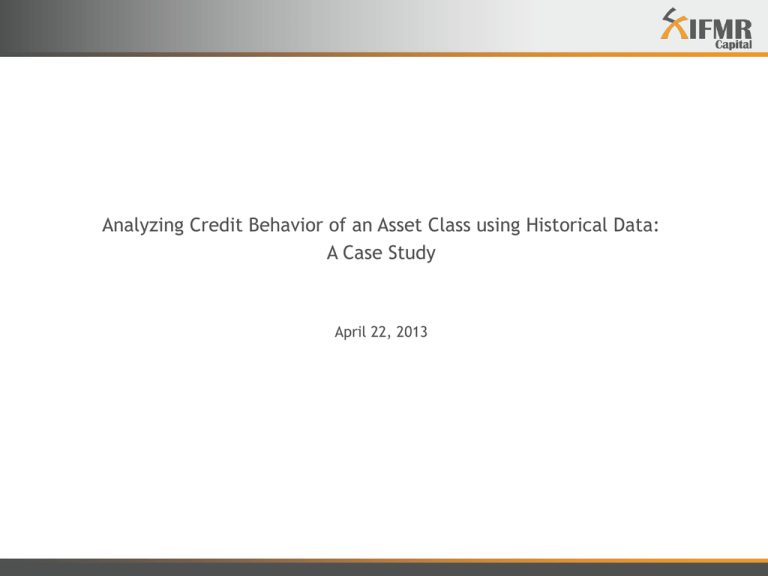to presentation - IFMR Finance Foundation
advertisement

Analyzing Credit Behavior of an Asset Class using Historical Data: A Case Study April 22, 2013 Acknowledgements ► My sincere thanks to Bama for letting me use certain slides from her presentation In memory of… all the ping pong balls sacrificed in the North-West corner Image source: http://cargocollective.com/rmattgarcia/Ping-Pong-Trophy-1 Agenda ► ► ► ► Asset Class and Data Scope of the study Methodology and findings Application Asset class and Data ► ► ► ► ► More than 115000 loans covering three asset classes: Two-wheeler loans, Commercial Vehicle loans, and MSME loans Following details were available over a period of 5 years: ► Monthly billing and recovery ► Loan amount ► Borrower Occupation ► Borrower income ► LTV (for a certain asset class) ► Tenure ► City/State Only such loans were considered for the study where the repayment information is available for at least 12 months More than 67000 loans were selected for the study We would refer the three asset classes as A, B and C (in random order) Scope of the Study ► ► ► Estimate transition probabilities to migrate from one PAR state to another Observe payment behaviour to understand the time a loan typically spends as PAR0 or PAR30 and whether loans default early or late in their ‘lifetime/tenure’ Observed transition probabilities for sub-portfolios of loans with certain seasoning, loan tenure and LTV for collateralized loans Methodology ► Estimating transition proportions: proxy for probabilities ► Suppose ‘x’ loans were observed in dpd-1 bucket during any time of the loan ► Of these ‘x’ loans, ‘y’ loans were also observed to be in dpd-30 bucket ► So, x/y is the proportion of loans which ever moved from dpd-1 to dpd-30 Methodology ► Estimating transition proportions: proxy for probabilities ► Suppose ‘x’ loans were observed in dpd-1 bucket during any time of the loan ► Of these ‘x’ loans, ‘y’ loans were also observed to be in dpd-30 bucket ► So, x/y is the proportion of loans which ever moved from dpd-1 to dpd-30 Figure 1: Transition Probabilities Methodology ► Estimating time-to-PAR ► For each loan which was ever observed in dpd-30, determine the time elapsed before it first entered the dpd-30 bucket ► Time elapsed could be observed in absolute scale (e.g. months) or in scale relative to its tenure (e.g. 30% of loan tenure) ► A frequency distribution of the time elapsed for all such loans could be useful Methodology ► Estimating time-to-PAR ► For each loan which was ever observed in dpd-30, determine the time elapsed before it first entered the dpd-30 bucket ► Time elapsed could be observed in absolute scale (e.g. months) or in scale relative to its tenure (e.g. 30% of loan tenure) ► A frequency distribution of the time elapsed for all such loans could be useful Asset A Asset B Figure 3: Time to Hit PAR30 Asset C Methodology ► Estimating Time-spent-in-delinquency ► As per the latest observation, a loan could be ‘Current/Mature’ or ‘Delinquent/Default’ ► For each ‘Current’ loan, determine the time spent as delinquent (Note that a loan, current now, could have been delinquent in the past) ► Similarly for each delinquent loan (no matter dpd-1 or dpd-180 or default), determine the time spent as delinquent ► ‘Time’ could be absolute or relative (though relative helps in comparing across tenures) Methodology ► Estimating Time-spent-in-delinquency ► As per the latest observation, a loan could be ‘Current/Mature’ or ‘Delinquent/Default’ ► For each ‘Current’ loan, determine the time spent as delinquent (Note that a loan, current now, could have been delinquent in the past) ► Similarly for each delinquent loan (no matter dpd-1 or dpd-180 or default), determine the time spent as delinquent ► ‘Time’ could be absolute or relative (though relative helps in comparing across tenures) Asset A Asset B Figure 2: Life Spent in Delinquency Asset C Application ► Consider a portfolio of loans of asset class A ► ‘Time-to-Default’ analysis would provide us the distribution of defaults over the tenure of loans (say 80% dpd-1 or PAR0 cases occur after 3 month or 25% of loan tenure and rarely after 75% of loan tenure) ► Use transition proportions to calculate losses and recoveries in subsequent periods ► Stress the assumptions on transition proportions and ‘time-to-default’ to test the portfolio Thank you









